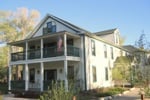PEARL LAKE STATE PARK
Pearls are a gift of nature and Pearl Lake State Park is just that. Just a few miles off the road, it feels like an escape into the back country of Colorado.
While day use and the Yurts are open and available, camping at Pearl Lake will be unavailable until Spring of 2010 due to hazard tree mitigation efforts. Please see the Conditions page on the left for more information.
Nestled in the mountains north of Steamboat Springs, this peaceful park sits in a quiet forest setting. Surrounded by mountains and trees, visitors camp along the lake and up a gentle hill.
There's excellent fly and lure fishing for native cutthroat trout as they flash their red throats when pulled from the water. This is a true escape from the day-to-day routine. A trail takes visitors along the shoreline and leads them deep into the forest. Picnicking is picture perfect among the big trees that frame the lake.
Pearl Lake Geology
The park is covered by Pleistocene till and Holocene alluvium on the west and north sides. Deposits of till are from terminal glacial moraines, and alluvium consists of bouldery fan, mountain basin gravel and flood plain sand and gravel deposits. South and east of Pearl Lake are exposures of Precambrian felsic gneiss and volcanic amphibolite.
Pearl Lake Plants
Major native plant communities at Pearl Lake are the following:
1. Sagebrush shrubland 2. Lodgepole pine forest 3. Northern subalpine forest 4. Aspen forest 5. Willow carr 6. Marsh 7. Wet meadow
Northern subalpine forest and lodgepole pine forest are the most common vegetation types at Pearl Lake. Northern subalpine forest, comprised of subalpine fir, Englemann?s spruce and Colorado blue spruce, exists more commonly on north-facing slopes. Herbaceous understory species in the lodgepole pine forest include broom huckleberry, geranium, strawberry, arnica and mountain brome.
The aspen forest community is characterized by a rich herbaceous understory of lupine, yarrow, geranium, meadow rue, wheat grass and Thurber fescue. Sagebrush shrublands occur on the northeast side of Pearl Lake. Big sagebrush dominates this community, though rabbitbrush and hoary sagebrush are other common shrubs.
Willow carr, marsh and wet meadow plant communities have become established around the reservoir, in Beaver Creek and in Lester Creek above and below the dam. Willow carr is a wetland shrub community dominated by a variety of willows including wolf, booth, geyer and shining willow.
Marshes are the most common wetland community at Pearl Lake and consist of sedges, rushes,and bulrushes growing in areas of permanent standing water. Small areas of wet meadow possess traits suggestive of periodic wet conditions, such as moist soil and hydrophytic vegetation. Common native species in the wet meadow include tufted hairgrass, elephantella, western bistort, shrubby cinquefoil and scouring rush.
Pearl Lake State Park Wildlife
Visitors may observe mule deer, as well as porcupine, red fox, pine squirrel, beaver or muskrat. Routt National Forest helps to preserve large tracts of contiguous habitat in the region. American marten, long-tailed weasel, tiger salamander, striped chorus frog and western terrestrial garter snake are also present.
Because dramatic late summer drawdowns do not occur at Pearl Lake, the reservoir exhibits characteristics similar to a natural lake with more constant shoreline conditions and water levels for migrating and resident wildlife. The restriction to wakeless boating on Pearl Lake contributes to the quiet and peaceful atmosphere at the park.
Over 200 species of migratory and resident birds are known in the park including northern harrier, osprey, great blue herons, western screech-owl, western bluebird, hairy and downy woodpeckers and red-winged blackbird. Greater sandhill cranes return to nest in the willow carrs and marshes in the spring. The park staff requests that visitors keep their distance when observing the cranes.
Fish
The cutthroat trout population at Pearl Lake is designated as Gold Medal. Brook and brown trout and grayling are occasionally reported.
All Colorado State Parks have entrance fees. All vehicles are required to have an entrance pass and some parks have walk-in fees. Visit the
Colorado Park Entrance Pass web page.
Day-UseFishingyes
Huntingyes
Hiking Trailyes
Swimming Beachyes
BoatingLaunch Rampsyes
CampingPrimitiveyes
Electric Sitesyes
All campsites at Pearl Lake can accommodate tents, trailers and smaller motor homes. Amenities include:
Level Parking Areas. Table/fire ring, 14 x 14 ft tent pads. All tents and equipment need to be set up on the high-use pads. Drinking water is available from hydrants located throughout the campground. Facilities also include vault toilets and one flush toilet located in the lower loop. Pearl Lake campers may use shower, laundry and dump station facilities at nearby Steamboat Lake. Snow conditions generally permit camping at Pearl Lake from late May through mid-October. The park is closed to camping during the winter, but check with neighboring Steamboat Lake State Park. Pets--on a leash and under control--are welcome. Please do not hang items from trees.


